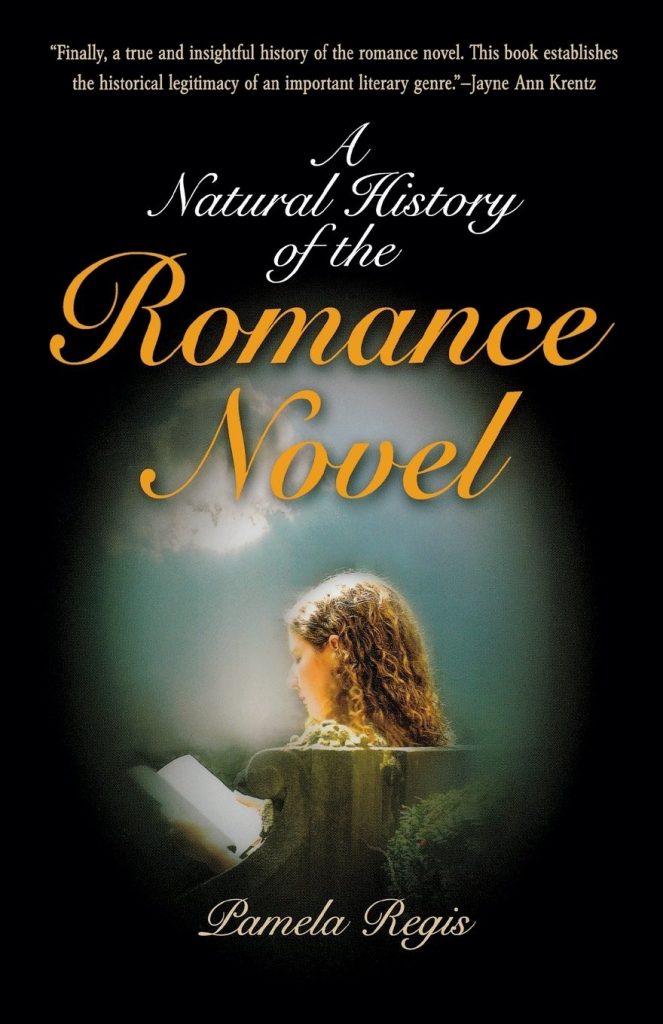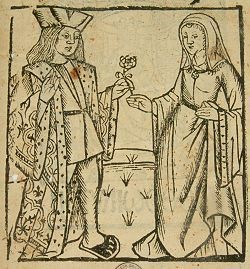Romance, as Barbara Fuchs has observed, “is a notoriously slippery category. Critics disagree about whether it is a genre or a mode, about its origins and history, even about what it encompasses” (1). I’d like to discuss first some definitions of popular romance and then its “origins and history.”
 Pamela Regis, author of the influential A Natural History of the Romance Novel (2003), defines a popular romance as “a work of prose fiction that tells the story of the courtship and betrothal of one or more protagonists,” a definition she amended so that it could “include m/m, f/f, and ménage romance novels” (“What”). She also stipulates that “Romance novels end happily” (Natural 9). This places her in the same camp as the Romance Writers of America. Founded in 1980, the organisation’s definition of the romance novel focuses on two elements: “a central love story and an emotionally satisfying and optimistic ending.” That said, one of the authors who helped formulate the RWA definition has clarified that “an emotionally satisfying and optimistic ending” is not necessarily wholly “happy”:
Pamela Regis, author of the influential A Natural History of the Romance Novel (2003), defines a popular romance as “a work of prose fiction that tells the story of the courtship and betrothal of one or more protagonists,” a definition she amended so that it could “include m/m, f/f, and ménage romance novels” (“What”). She also stipulates that “Romance novels end happily” (Natural 9). This places her in the same camp as the Romance Writers of America. Founded in 1980, the organisation’s definition of the romance novel focuses on two elements: “a central love story and an emotionally satisfying and optimistic ending.” That said, one of the authors who helped formulate the RWA definition has clarified that “an emotionally satisfying and optimistic ending” is not necessarily wholly “happy”:
some of the best romances don’t have happy endings, they’re bittersweet. […] The discussions on this one pretty much boiled down to “endings that make the reader feel good at the end of the book.” No endings where the protagonists sacrifice for one another and end up noble and alone […] and definitely no finales with dead protagonists unless they’re ghosts having a terrific time in the afterlife. (Crusie)
The older, UK-based, Romantic Novelists’ Association merely state that if a “love story” is the main “strand of your novel” then “you’ve written a romantic novel.” As their name suggests, they seek to define not “romance” but “romantic” fiction but their lack of concern about the nature of the ending of the novels may be shared about some scholars of romance. Lynne Pearce, for example, has written about “romances that end in death” (534) and John G. Cawelti felt that:
the moral fantasy of the romance is that of love triumphant and permanent, overcoming all obstacles and difficulties. Though the usual outcome is a permanently happy marriage, more sophisticated types of love story sometimes end in the death of one or both of the lovers, but always in such a way as to suggest that the love relation has been of lasting and permanent impact. (41-42)
Barbara Fuchs suggests that “romance, as a critical idiom, may be most useful to contemporary readers if it […] is conceptualized as a set of literary strategies that can be adopted by different forms” (2) and therefore defines it as “a concatenation of both narratological elements and literary topoi, including idealization, the marvelous, narrative delay, wandering, and obscured identity, that […] both pose a quest and complicate it” (9).

The majority of those working within the relatively new field of popular romance studies, however, have tended to subscribe to definitions of “popular romance” which reflect the use of the term “romance” in the US fiction market, namely those of the RWA and Regis, which insist on both a central love story and a happy or optimistic ending.
Most of the academic research on popular romance focuses on twentieth and twenty-first century texts, although many consider the popular romance to have originated in an earlier period. Love stories can probably be traced back to the beginning of storytelling itself, since they are to be found in myths, legends and folk tales. The prose romance existed but had a “ low status in antiquity” due to “the fact that it offends against the decorum of genre. The Greek romances are all written in prose, which was traditionally the medium for serious, particularly historical, writing” (Williamson 23). Nonetheless, they were popular: “critical disparagement of these works was not shared by the reading public. The number and distribution of papyrus finds suggest, on the contrary, that they had considerable popularity” (24). Leaping forward in time, Middle English romance has been described as: “‘Popular’ in its capacity to attract a large and heterogeneous medieval audience, as well as in its ability to provide that audience with enormous enjoyment” (McDonald 2). Renaissance romances too have often been compared to modern ones and, as “their shared label of ‘romance’ implies, Renaissance romance and modern romance have in common some […] qualities, and a shared interest in plots of courtship” (Hackett 21). Jumping forwards yet again, Samuel Richardson’s Pamela (1740), is declared by Pamela Regis to be, if “not the first novel in English, nor yet the first romance novel, […] the first best seller” (Natural 63).

In The Cambridge Companion to Popular Fiction David Glover and Scott McCracken “identify the late nineteenth century as the period when the genres that constitute so much of popular fiction emerge” (1). As far as popular romance fiction is concerned, a starting point in the second half of the nineteenth century has its proponents in Rachel Anderson, who stated that “popular romantic fiction began in 1853 with the publication of The Heir of Redclyffe by Charlotte M. Yonge” (25), and William Gleason, who argues that “The mass marketing of modern romance fiction in North America began not with the emergence of Harlequin Books in the 1950s but during the dime novel and story paper boom of the 1860s and 1870s.” Others may prefer to situate the true emergence of the romance in its modern form at the beginning of the twentieth century, which saw the publication of a number of romance novels which, though now almost solely of academic interest, were hugely popular in their day, including Florence Barclay’s The Rosary (1909), Ethel M. Dell’s The Way of an Eagle (1910) and E. M. Hull’s The Sheik (1919).
—
References:
Anderson, Rachel. The Purple Heart Throbs: The Sub-literature of Love. London: Hodder and Stoughton, 1974.
Cawelti, John G. Adventure, Mystery, and Romance: Formula Stories as Art and Popular Culture. Chicago: U of Chicago P, 1976.
Fuchs, Barbara. Romance. New York: Routledge, 2004.
Gleason, William. “Belles, Beaux, and Paratexts: American Story Papers and the Project of Romance.” Journal of Popular Romance Studies 2.1 (2011).
Glover, David and Scott McCracken. “Introduction.” The Cambridge Companion to Popular Fiction. Ed. David Glover and Scott McCracken. Cambridge: CUP, 2012. 1-14.
Hackett, Helen. Women and Romance Fiction in the English Renaissance. Cambridge: CUP, 2000.
McDonald, Nicola. “A polemical introduction.” Pulp Fictions of Medieval England: Essays in Popular Romance. Ed. Nicola MacDonald. Manchester: Manchester UP, 2004. 1-21.
Pearce, Lynne. “Popular Romance and its Readers.” A Companion to Romance: From Classical to Contemporary. Ed. Corinne Saunders. Oxford: Blackwell, 2004. 521-38.
Regis, Pamela. A Natural History of the Romance Novel. Philadelphia: U of Pennsylvania P, 2003.
Regis, Pamela. “What Do Critics Owe the Romance? Keynote Address at the Second Annual Conference of the International Association for the Study of Popular Romance.” Journal of Popular Romance Studies 2.1 (2011).
RWA. “About the Romance Genre.”
Williamson, Margaret. “The Greek Romance.” The Progress of Romance: The Politics of Popular Fiction. Ed. Jean Radford. London: Routledge & Kegan Paul, 1986.
Bio: Laura Vivanco is an independent scholar whose PhD thesis from the University of St Andrews was published in 2004 as Death in Fifteenth-Century Castile: Ideologies of the Elites. She has been active in popular romance studies for over a decade and her work in that field includes For Love and Money: The Literary Art of the Harlequin Mills & Boon Romance (2011) and Pursuing Happiness: Reading American Romance as Political Fiction (2016).
Website: http://www.vivanco.me.uk/
